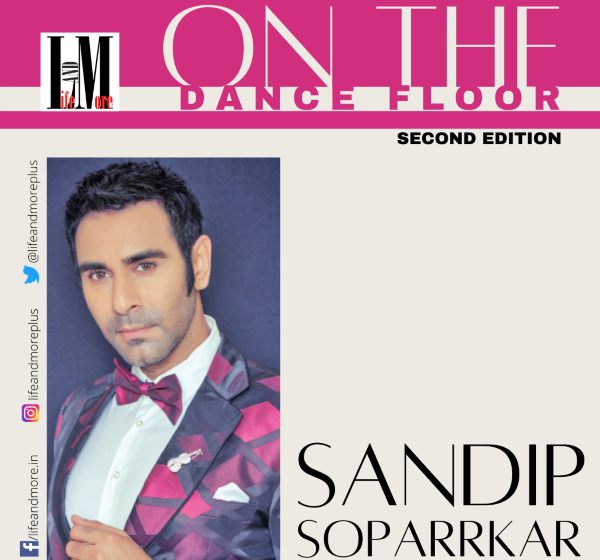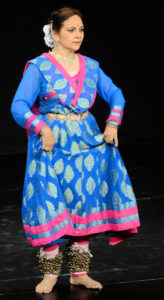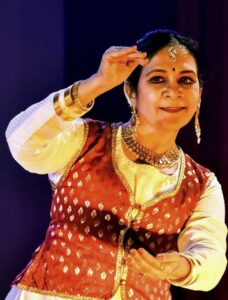Kathak kavittavs come alive, courtesy Ranjana Phadke & Nilima Hirve

Kathak is indeed one of the most popular classical dance forms of our country, with three main Gharanas ((Lucknow, Jaipur and Banaras), each with its own beautiful and unique style and class. But, the common thread is these is the kavittav or Kavitta or Poetries, which are performed on taal – gestures and expressions are used to tell the katha (story) making kavittav a very important and interesting aspect of Kathak dance. Kavittavs are mostly written in Hindi, Avadhi or Brij Bhasha. Many scholars have written numerous kavittavs. Pt Sukhdev Maharaj (Banaras Gharana), Pt Lachhu Maharaj (Lucknow Gharana) Pt Narayan Prasad (Jaipur Gharana), Ved Mani Sinha Thakur from Raigad Gharana, Pt Rohini Bhate and many more have written numerous kavittavs, on subjects varying from Radha Krishna stories, Lord Shiv, Lord Ganesh to different Nayikas and Rasas.
Recently Ranjana Phadke, an accomplished Kathak dancer, acclaimed teacher and renowned choreographer who is recognized for her commitment, devotion and dedication to Kathak for the last three decades decided to document and present various kavittavs.
Phadke who underwent intensive training to master the rich narrative, craft and technical aspects of Kathak, has deep understanding of the complexities of rhythm and creative ability to express a range of emotions flawlessly. A post graduate in kathak, she holds the degree of Nritya Alankar from Gandharva Mahavidyalaya. I spoke with the creative dancer and tried to know more about why she did what she did:
What made you think of documenting and presenting kavittavs?
It so happened that Ishavasya Gurukul asked me to interview senior Dancer Manjiri Deo – a dance scholar who holds a PhD in Kavittavs. To know more about her and her subject, I read her book – a collection of numerous kavittavs, which amazed me no end. I found so many beautiful kavittavs which I had not seen in my 30 years of dance career. That’s is when I immediately decided to work on this project. Unfortunately, the interview got cancelled but it motivated me to do some documentation which I know will be useful for dancer world over.

How did you go about putting it all together?
I roped in my dancer friend Nilima Hirve. In some kavittavs, pakhavaj syllables are interwoven beautifully, in some bols, while still others are only with sahitya – kathak is rich in this aspect. Then I thought why not do padhant in the best possible way and post on social media. Our main intention was not only kathak students but anybody can perform with the help of the videos. Social media works wonders. After every episode we took feedback from our seniors and got tremendous response.
Which was the first kavittav?
The first episode was a simple one – it had Lord Ganapati kavittavs and stutis. Then we brought forward kavittavs on Lord Shiva. As we moved ahead, we kept improvising. I must thank Guru Shama Bhate who suggested us after third episode to not just use Vachik Abhinaya but to also perform each kavittav. Under her guidance we went ahead with two more episodes of kavittavs. which got a thunderous response from senior dancers. That is when we realized that we were on the right track, thereafter we made seven episodes.
How many kavittavs have you done till now and what next?
We have completed almost 50 kavittavs. We intend to document 108 kavittavs, each with words and performance both. I am planning to rope in other dancers too now and make this project more enriching for all. In the past whatever I have done was always to satisfy my creativity. But now it has gone lot beyond that. This project is on a very larger scale, the vision is global and the ones who will be benefited are present worldwide. I assure you that even after a century if someone refers to these episodes of our kavittavs they will be gain tremendously.
How has the entire preparations been?
It was not easy for us at all, some kavittavs were really difficult and unheard of. The language of some kavittavs is so tough that it was extremely difficult for us to interpret and understand. I did not want to change the words to suit current times – this is when help from seniors came in handy. Some kavittavs are brilliantly composed and supremely hard to understand but, like it is said ‘Practice makes a man perfect’ our dance and recital practice worked and what you see now is interesting to hear and simple to comprehend.



